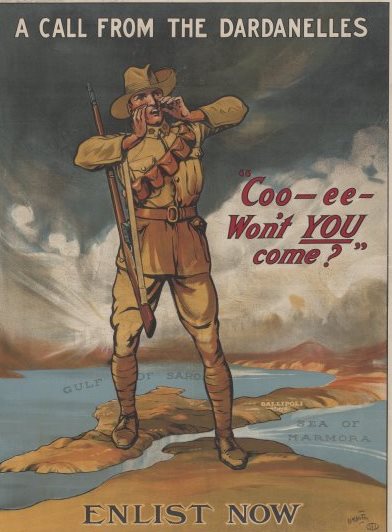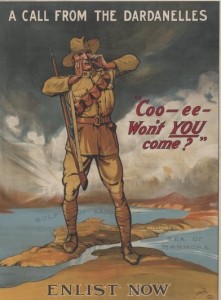The Coo-ee March was a recruitment drive in response to dwindling World War I enlistments following the huge casualty count of the Gallipoli campaign and the increasing number of casualties in France during 1915. The march was the first to be organised in New South Wales and it inspired others in the eastern states including the Central West Boomerangs (Parkes), the Kangaroos (Wagga Wagga), the Kookaburras (Tooraweenah), the Kurrajongs (Inverell), the North Coast Boomerangs (Grafton), the Wallabies (Walgett), the Waratahs (Nowra), the Dungarees (Warwick)and the Men from Snowy River (Delegate).
In August 1915 Gilgandra local plumber and rifle club member William T (“Captain Bill”) Hitchen proposed a 515km long march route from Gilgandra to Sydney, passing through Balladoran, Eumungerie, Mogriguy, Dubbo Wongarbon, Geurie, Wellington, Dripstone, Mumbil, Stuart Town, Euchareena, Boomey, Molong, Orange, Millthorpe, Blayney, Bathampton, Bathurst, Yetholme Wallerawang, Lithgow, Little Hartley, Mt Victoria, Katoomba, Lawson, Springwood, Penrith, Parramatta, Ashfield, terminating in the centre of Sydney.
On 10 October 1915 “Captain Bill” and 25 men left Gilgandra. Upon arriving at each town on the route they shouted “Coo-ee! Come and join us!” to attract recruits. They demonstrated their military drills; gave impassioned speeches and enjoyed the local hospitality.
More than 100 men arrived in Orange almost two weeks later, on Saturday 23 October. As they left Molong that morning it had started to rain, so they decided to forgo lunch and forge on, arriving in Orange at midday, ahead of schedule and totally drenched.
The official reception was scheduled for 3pm, so the Mayor, Ald ET McNeilly met them at the edge of town and led them through the back streets to the pavilion at Wade Park, where he issued them with dry socks and prescribed “two ounces of medicine” per man. Meanwhile Mrs McNeilly and a team of volunteers prepared a hot meal.
The Coo-ees were then escorted back to the edge of town for their official arrival. Despite the ongoing rain a crowd of some 4,000 people congregated along Summer Street to watch them march down, led by the Orange Town Band.
The men spent two nights in Orange, during which time 22 locals joined them. They left on the Monday morning for Lucknow and then Millthorpe. By the time they reached Lithgow on 2 November many of the men had worn out their boots, and had to be fitted with new footwear.
At noon on Friday 12 November 263 men reached Martin Place in Sydney, having covered a distance of 515km. They were greeted by Prime Minister Billy Hughes and an enthusiastic crowd of 100,000 people.
After four months training at the Liverpool camp the Coo-ees embarked the Star of England for Egypt where some served with the 13th Battalion; others joined the 45th Battalion. All served in France.
The manager of the Monarch Picture Palace in Orange filmed sections of the Coo-ee March. According to the Leader there was, “1100 feet of film … depicting the crowd lining the route of march down Byng Street, the reception at the Town Hall, and incidents connected with the contingent.” Also “the entry into Wellington, Lithgow, Katoomba, etc. till the final grand entry into Martin Place, Sydney… We understand that the pictures are exceedingly clear, and a triumph in local motion photography.”
Many copies of the movie were made and screened throughout NSW, however there appear to be no surviving copies.
Twenty–two men joined the Coo-ee march in Orange:
Bernard Ambrose Coyte, Charles William Gordon Conroy, Harry Davenport, Joseph Parrish, Leslie Reginald Anlezark, Charles Carmichael, William Aubrey Collyer, Charles P Corbett, Thomas Culley, Thomas Walter Dowd, Edwin Joseph Fuller, Arthur Gilchrist, SJ Deloury Hewston, George Allen Lloyd, William Sidney Lovett, Thomas McGrory, Alfred Fletcher McLean, Ernest Charles Norman May, Ernest Morris, William John Shannon, James Taylor, John William Thompson.
Four of these men would not return; Bernard Ambrose Coyte and Charles William Gordon Conroy would be killed in action, Harry Davenport and Joseph Parrish would die of wounds.



A great post on the Coo-ees at Orange.